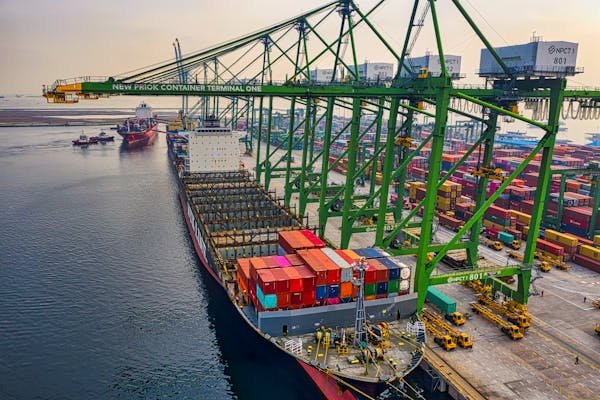Shipping costs have been on a rollercoaster in the past few years. What started with sky-high prices during the pandemic has now started to stabilize in many areas, but not everywhere. As a result, businesses, especially those that depend on imports and exports, need to keep a very close eye on freight rate trends by region. In this article, we’ll break down the latest shipping statistics by region, one at a time. Each stat reveals something powerful about what’s happening in the global logistics landscape.
1. Asia–Europe container shipping rates dropped by over 80% in 2023 compared to 2022 highs
What happened and why it matters
The drop in shipping rates between Asia and Europe was not just a dip—it was a freefall. From pandemic peaks that saw containers moving at sky-high rates, we’re now seeing numbers that resemble the pre-pandemic market.
In 2022, freight costs on this route were reaching astronomical highs—sometimes upwards of $14,000 per 40-ft container. But by the end of 2023, these prices came crashing down by more than 80%.
The main drivers?
- A slowdown in consumer demand across Europe.
- Increased shipping capacity with new vessels entering service.
- Easing of port congestion and improved supply chain flow.
Actionable Takeaways
Rethink your contract strategy
If you signed long-term freight contracts during the high-cost periods, you’re likely overpaying now. As rates fall, consider renegotiating those deals or switching to more flexible short-term contracts.
Review your logistics partnerships
Are your freight forwarders passing on the savings to you? It’s time to ask. If not, it may be time to explore better-aligned partnerships.
Invest in visibility tools
With falling costs, the focus now shifts to speed and transparency. Use digital tools that show real-time freight pricing and help you choose the best option.
Forecast smartly
While prices are down now, things can change quickly. Build forecasts that include scenarios of rising prices so you’re never caught off guard again.
Diversify routes when possible
Don’t depend only on one corridor. Look into alternative routes or multimodal solutions to build a more resilient freight network.
2. Trans-Pacific rates (China to US West Coast) fell from $15,000 per FEU in 2021 to under $2,000 in early 2024
Why this drop is such a game-changer
The trans-Pacific trade lane has always been one of the most volatile. During the height of the pandemic, demand was surging and supply was bottlenecked. That led to costs as high as $15,000 per forty-foot equivalent unit (FEU). Fast forward to early 2024 and you’re looking at sub-$2,000 rates.
What caused this collapse?
- Improved efficiency at US West Coast ports like Los Angeles and Long Beach.
- Diminished consumer spending on goods and a shift toward services.
- Carriers adding too many ships to the route, leading to overcapacity.
Actionable Advice
Audit your shipping history
Review how much you were paying two years ago vs. now. You may find significant cost-cutting opportunities, especially if your contracts haven’t been updated.
Re-evaluate your warehousing strategy
With shipping costs down, you may not need to keep as much inventory onshore. That could reduce your warehousing expenses.
Negotiate with confidence
Don’t accept rates blindly. Use this stat as leverage to negotiate better deals with freight carriers or freight forwarders.
Expand into new markets
If you previously avoided West Coast entry points due to high shipping rates, now’s a good time to reconsider. Lower freight rates could make new markets viable again.
Be ready for change
Prices this low may not stick forever. Keep a close watch on macroeconomic signals like fuel prices, consumer demand, and trade policy.
3. Spot freight rates globally decreased by 64% YoY in late 2023
The Spot Rate Slide: What It Means for Businesses
Spot freight rates are like the heartbeat of global shipping. Unlike contract rates, which are locked in over time, spot rates reflect what shippers are paying right now on the open market. When these rates fell by 64% year-over-year in late 2023, it signaled something major: the power in the freight market shifted from carriers back to shippers.
This change came as global demand softened. Consumers weren’t buying as much. Retailers had already overstocked during the pandemic and were now dealing with excess inventory. At the same time, new shipping capacity that had been ordered during the boom started hitting the water.
Carriers had more room on their ships and fewer containers to move. That imbalance forced them to drop prices to fill space.
This shift wasn’t limited to one route or region—it was a worldwide trend. Whether you were shipping from Southeast Asia to the US, from Europe to the Middle East, or across Latin America, spot rates saw massive declines.
What You Should Be Doing Now
Take advantage of timing
If your contracts are about to renew or you have flexibility to use spot market bookings, this is your chance to lock in savings. You might be able to pay less for the same service—or even upgrade your speed or route for the same budget.
Balance risk and reward
Spot rates are lower, but they’re also less predictable. If you rely on predictable logistics, don’t abandon your contracts entirely. Instead, create a hybrid freight strategy where part of your volume goes through spot, and the rest is contract-based.
Update your pricing model
If you pass on shipping costs to your customers, it’s time to reassess your pricing. Lower shipping expenses could be turned into competitive advantage through better pricing—or improved profit margins.
Monitor rate volatility
Use rate tracking tools. Rates can bounce back fast depending on fuel spikes, geopolitical events, or demand rebounds. Stay informed so you can act fast when things change.
Rethink product sourcing
When freight is cheap, distance becomes less of an issue. Products that were once too expensive to import might now be viable again. Run new cost comparisons and expand your supplier options.
4. The Shanghai Containerized Freight Index (SCFI) declined from 5,000 in Jan 2022 to under 1,000 in 2024
SCFI: Why This Index Is Crucial
The Shanghai Containerized Freight Index (SCFI) tracks the spot rate prices for container transport from Shanghai to major ports around the world. It’s often seen as a bellwether for the broader container shipping market.
In January 2022, the SCFI was hovering around 5,000 points—more than five times the pre-pandemic average. It was a red-hot market. Fast forward to 2024, and that same index has dropped below 1,000.
This sharp decline tells us several things:
- The red-hot demand from 2021 and 2022 wasn’t sustainable.
- There’s now significant overcapacity in the market.
- Shippers are regaining pricing power.
While this might seem like great news for importers and exporters, it also signals risk for ocean carriers, and in the long run, instability in the supply chain if rates dip below sustainable levels.
Tactical Moves You Can Make
Track SCFI weekly
Make a habit of watching the SCFI like you would stock prices. It gives you a weekly view into what’s happening with ocean freight rates and can help you plan your logistics strategy.
Review carrier health
When rates fall too low, carriers start cutting services, consolidating routes, or even canceling sailings. Be alert to signs of “blank sailings” (canceled trips), which can delay your shipments.
Lean into flexibility
With rates low, you may have room to renegotiate not just prices, but service terms too. Think priority loading, better transit time guarantees, or simplified documentation requirements.
Budget with realism
Don’t assume low rates are forever. Plan for a scenario where SCFI might bounce back to 1,500–2,000. Budget conservatively so you’re ready for rate shocks.
Look for bundled value
Some carriers, desperate to fill space, are offering value-added services like customs support, last-mile delivery, or insurance at a discount. Take advantage of these bundles.
5. Drewry’s World Container Index has stabilized around $1,700 per 40-ft container in Q1 2024
What This Means for Predictability in Freight
After two years of roller-coaster freight prices, one word is finally entering the conversation again: stability. Drewry’s World Container Index, which monitors average global freight rates across key routes, has found a landing spot around $1,700 per forty-foot container as of the first quarter of 2024.
This is a return to near-normal pricing when compared to pre-pandemic levels, which hovered between $1,200–$1,800 depending on the month. It suggests that while we’re not at the rock bottom, we’ve exited the peak turbulence.
Why is this index important? Because it’s global. It gives you a broader picture beyond regional volatility and shows how different markets are converging in price behavior.
Smart Ways to Use This Information
Stabilize your logistics budget
Now that prices are more predictable, you can set shipping budgets with more confidence. Use the $1,700 benchmark as a realistic baseline for global average container costs.
Negotiate better contracts
Use the stabilization as a signal in your contract negotiations. If your logistics provider is still using last year’s pricing as a base, it’s time to push back.
Improve planning cycles
Volatile freight markets forced many businesses into reactive mode. Now’s your chance to return to proactive planning. Lock in your shipments earlier, and coordinate better with suppliers.
Create cost buffers
While the market is stable for now, it doesn’t mean surprises are gone forever. Allocate small buffers in your landed cost estimates to absorb any rate swings.
Optimize inventory turnover
With predictable freight rates, you can better plan your order volumes and restock timing. That reduces the need for safety stock and can free up working capital.
6. Transatlantic Eastbound rates remained higher than pre-pandemic levels at $3,000+ per FEU in early 2024
Why the Transatlantic Route Is Still Expensive
Unlike the Asia–Europe or Trans-Pacific routes, transatlantic eastbound freight rates haven’t dropped back to pre-pandemic levels. Even in early 2024, rates for a 40-foot container from the US to Europe hover above $3,000—significantly higher than the $1,500–$2,000 norm before 2020.
Why haven’t these prices come down?
- Trade imbalance: There’s more demand to ship goods eastbound (from the US to Europe) than westbound.
- Limited vessel availability: Carriers still prioritize more profitable routes.
- Stronger US exports: High demand for industrial goods, chemicals, and food products has kept volumes high.
- Port congestion and inland bottlenecks: These continue to impact schedule reliability, particularly on the East Coast of the US.
How You Can Respond Strategically
Avoid outdated assumptions
If you’re using historic benchmarks to estimate shipping costs for this corridor, you might be way off. Update your freight assumptions and models.
Explore backhaul deals
Ask your logistics partners about backhaul opportunities. Sometimes, ships returning to Europe are willing to offer discounts to fill space.
Time your shipments smartly
Monitor shipping schedules and aim for off-peak periods when fewer exporters are competing for space. Booking early is essential.
Improve load planning
If you’re shipping partial loads (LCL), consider consolidating with other exporters to move to FCL and save on per-unit costs.
Benchmark against peers
Don’t just accept quotes. Compare what others in your industry are paying. Use third-party platforms or industry groups for pricing intelligence.
7. Inland trucking rates in North America fell by about 20% YoY due to softened demand
The Downward Shift in Road Freight
Trucking in North America—particularly for long-haul and regional shipments—saw a 20% drop in rates year-over-year as of late 2023. This shift came as inventory levels normalized and shipping volumes declined post-pandemic.
Fewer goods needed to be moved from ports to distribution centers or warehouses, which led to:
- Excess truck capacity
- Increased competition among carriers
- A drop in diesel fuel prices, easing operating costs
Smaller carriers were hit hardest, while larger trucking firms adjusted by optimizing routes or cutting costs.
What This Means for Your Business
Renegotiate your ground contracts
Use the dip in rates to revisit your agreements with local and national carriers. Lock in better terms now while rates are still soft.
Review last-mile strategies
With lower trucking costs, it may make financial sense to increase delivery frequency or reduce delivery windows for customers.
Plan around fuel efficiency
Use the drop in diesel prices to plan longer or more complex shipping routes without major cost hikes.
Evaluate your 3PLs
Third-party logistics providers should be passing these savings on. If they’re not, ask for a detailed breakdown or explore competitive alternatives.
Factor trucking into your landed cost
Make sure your total landed cost reflects the new trucking rates—it could affect product pricing, especially for bulky or low-margin items.
8. Diesel fuel costs in the US dropped by 18% in 2023, impacting freight charges
Fuel Costs: The Hidden Lever Behind Freight Rates
Diesel is the lifeblood of road freight. When diesel prices drop, trucking companies can lower their operating costs—and that impacts freight pricing, surcharges, and profitability.
In 2023, the US saw diesel fuel prices fall by 18% on average. This happened due to a mix of improved global fuel supply chains, lower crude oil prices, and fewer geopolitical disruptions than in 2022.
For many businesses, this wasn’t just a fuel story—it was a freight cost story. Lower diesel prices led to smaller fuel surcharges, better spot rates, and greater pricing flexibility.
Here’s How You Can Capitalize
Track fuel surcharge indexes
Many carriers link their surcharge formulas to fuel indexes. When prices drop, those surcharges should too. Double-check if your invoices reflect that.
Use cost savings for service upgrades
If you’ve saved money on fuel-related costs, consider upgrading your freight options—faster delivery, temperature-controlled units, or better tracking systems.
Include fuel outlook in planning
While prices are down now, fuel markets are always vulnerable to spikes. Build some buffer into your freight budgets.
Push for fuel-linked contracts
Structure your freight agreements to include fuel triggers. This ensures pricing adjusts up or down based on the actual cost of diesel.
Evaluate alternative fuels
With diesel prices falling, electric trucks and alternative fuels may seem less attractive. But long-term sustainability and compliance still matter—don’t take your eye off that ball.
9. European road freight rates declined by 7.5% in Q4 2023
A Rebalancing of the European Freight Market
Europe’s trucking market is vast, diverse, and often unpredictable. In Q4 2023, rates dropped by 7.5% as a mix of economic slowdown, inventory correction, and reduced retail demand eased pressure on road logistics.
Several key trends emerged:
- Fewer cross-border loads were moving due to weaker consumer demand in Germany, France, and Italy.
- Labour availability improved slightly, reducing wage pressure.
- Fuel costs came down, easing operating margins for carriers.
This decline created a more favorable environment for shippers, especially those moving goods across the EU.
Smart Strategies for EU-Based Logistics
Explore cross-border savings
Freight rates vary widely across EU borders. Consider running simulations to see where cross-border moves offer cost advantages.
Audit your route planning
Are your trucks taking the most efficient paths? With reduced congestion and fuel costs, you may find ways to consolidate routes or reduce transit time.
Revisit volume discounts
Carriers with extra capacity are more willing to negotiate on volume. If you ship regularly within the EU, ask about improved rate tiers.
Understand regulatory shifts
New EU road transport rules may still affect pricing depending on region and vehicle type. Make sure your freight partners are compliant and transparent about any added costs.
Time shipments for savings
Mid-week shipments often cost less than weekend or Monday pickups. Use the softening market to adjust your schedule strategically.
10. Air freight rates from Asia to North America dropped by 35% YoY in 2023
The Air Freight Market Took a Breather
Air freight is the go-to option when time is tight, and cost is a secondary concern. But it also tends to be very sensitive to global economic shifts. In 2023, the air freight market from Asia to North America cooled significantly, with rates dropping by 35% year-over-year.
Why the big drop?
- Weaker demand for consumer electronics and high-value goods.
- Greater availability of passenger flights (and belly cargo space) post-pandemic.
- Companies returning to sea freight as supply chains stabilized.
This route, once jammed with emergency shipments and premium goods, has found breathing room again.
What Businesses Can Do About It
Switch back to air selectively
If you had moved away from air freight during the pricing surges of 2021–2022, now might be the time to revisit it—especially for mid-value goods that need fast delivery.
Optimize for hybrid models
Use a mix of air and ocean to balance cost and speed. For example, high-margin products can ship via air, while the rest go by sea.
Ask about flexible cargo programs
Many airlines now offer deferred air freight services that are slightly slower but far cheaper. These can be great for semi-urgent shipments.
Review your Incoterms
Work with suppliers to optimize who pays for freight. With lower air rates, you may want to take control of shipping to lock in better deals yourself.
Don’t forget about fuel surcharges
Even when base rates drop, fuel surcharges can remain high. Always review the full rate breakdown to avoid surprises.
11. Middle East freight costs rose by 12% in early 2024 due to Red Sea disruptions
Geopolitics Meets Logistics
The Middle East is often a hotbed for geopolitical shifts, and 2024 was no different. Freight costs in the region spiked by 12% early in the year, driven largely by instability and security concerns in the Red Sea area.
Here’s what caused the uptick:
- Vessel rerouting due to conflict zones.
- Port inspection delays and security screenings.
- Insurance premiums rising on high-risk lanes.
- A general sense of uncertainty forcing carriers to build in buffers.
These cost increases were especially felt on shipments going through or around the Suez Canal, affecting trade between Asia, Europe, and the Gulf.
What You Can Do Proactively
Build geopolitical risk into planning
Don’t assume stability. Always have a Plan B when it comes to regional routing, especially in politically volatile zones.
Use multiple carriers
Diversify your shipping options. Relying on a single carrier or transit route can leave you vulnerable during disruptions.

Reassess delivery timelines
With added risks and rerouting, transit times will fluctuate. Communicate clearly with customers and build in buffers when necessary.
Negotiate shared risk contracts
Talk to your logistics providers about contracts that spread the impact of disruptions instead of passing all costs onto you.
Monitor port advisories
Stay in the loop on what’s happening at key ports like Jeddah, Aden, and Port Said. Real-time data can help you adjust on the fly.
12. Latin American shipping routes saw a 14% increase in costs due to port congestion
Latin America: Growth Meets Infrastructure Gaps
Shipping routes into and out of Latin America became more expensive in 2023, with a 14% increase in freight costs. The root of the issue? Port congestion.
Major ports in Brazil, Mexico, Chile, and Colombia struggled to keep up with container volumes. This congestion caused delays, extended dwell times, and ultimately led to carriers adding surcharges or pushing prices up.
Some key challenges:
- Limited berth availability.
- Underinvestment in port modernization.
- Labor shortages and strikes.
- Seasonal agricultural export spikes.
Practical Tips for Navigating This Market
Book early, ship smart
Advance booking is your best weapon against port congestion. Don’t wait until the last minute or you may face serious delays.
Build stronger carrier relationships
Carriers will often prioritize regular customers or those with consistent volumes. Develop relationships that earn you better treatment.
Use alternate ports
In some cases, secondary ports may offer faster throughput even if they require more inland trucking. Compare total transit times, not just port-to-port.
Expect surcharges
Budget for temporary congestion surcharges. Treat them as a reality of doing business in this region.
Factor seasonality into planning
Agricultural exports can spike demand unpredictably. Time your shipments to avoid peak harvest months where possible.
13. Africa-Europe routes had a 10% rise in shipping charges owing to infrastructure delays
The Infrastructure Lag Holding Back Trade
Trade between Africa and Europe is growing, but not fast enough to match the infrastructure supporting it. In 2023, shipping costs between the two regions rose by 10%. Why? Infrastructure delays.
This included:
- Port development projects stalling or falling behind.
- Under-equipped terminals with outdated technology.
- Road and rail bottlenecks slowing inland container movement.
Ports like Lagos, Mombasa, and Dar es Salaam remain essential hubs but continue to struggle with scale and modernization.
Tactics to Manage This Region’s Freight Challenges
Stay updated on infrastructure news
Changes to port capacity or customs processes can affect costs overnight. Subscribe to shipping bulletins for the region.
Use logistics partners with local expertise
Don’t rely solely on global freight forwarders. Regional players often have better insight and faster access to port slots.
Plan for longer lead times
Factor in buffer days when importing or exporting to and from Africa. The extra margin can save you from emergency freight costs.
Negotiate resilience, not just price
In this region, service reliability can be more valuable than a small discount. Work with carriers who have a proven track record navigating delays.
Explore inland ports
Some countries offer dry port options that can reduce congestion at coastal terminals. These can be useful for high-volume shipments.
14. Panama Canal drought-related surcharges raised rates by $500–$1,000 per container in Q1 2024
Weather Meets Logistics in the Panama Canal
In Q1 2024, a severe drought caused water levels in the Panama Canal to drop, affecting the passage of ships. To compensate, the Panama Canal Authority restricted the number of transits per day and reduced allowable draft levels.
This led to immediate consequences:
- Backlogs at canal entry points.
- Higher competition for canal slots.
- Imposed surcharges ranging from $500 to $1,000 per container.
For shippers relying on this key artery—especially routes connecting Asia with the US East Coast or Latin America—the price hike was unavoidable.
What to Do When Nature Strikes
Adjust routing plans quickly
Some cargo may be better off routed through the Suez Canal or shipped to the West Coast and moved inland. Run alternate cost simulations.
Work with NVOCCs
Non-vessel operating common carriers often have better access to limited space and can secure better rates during high-demand periods.
Expect seasonal issues
Drought patterns can persist or return. Build seasonal risk into your route planning, especially for Q1 and Q3 when rainfall is limited.
Increase booking windows
With fewer slots available, it’s essential to book weeks ahead—not days. Talk to your forwarders early to reserve transit.
Know your container weight
Shallow draft levels mean heavier containers may be restricted. Plan shipments to stay under draft limits to avoid penalties or delays.
15. Freight rate volatility index rose by 22% globally in the last 6 months of 2023
When Freight Becomes a Rollercoaster
Volatility in freight pricing isn’t new, but a 22% jump in the freight rate volatility index within just six months is significant. This rise means shippers faced wider and faster swings in the cost to move goods—sometimes from week to week.
Several key factors drove this instability:
- Shifting demand patterns across sectors.
- Geopolitical issues, including conflicts and sanctions.
- Port congestion that came and went unpredictably.
- Rapid changes in oil prices.
- Uncertainty around environmental regulations affecting fuel and vessel types.
This volatility makes planning and budgeting much harder for businesses—especially those with thin margins or long lead times.
How to Tame the Chaos
Use dynamic pricing models
If you’re still working off static freight rate spreadsheets, it’s time for a change. Use dynamic models that update with real-world market inputs.
Add a buffer to budgets
Build contingency into your logistics spend. When volatility rises, having a small buffer (even 5–8%) can make a big difference.
Diversify shipping modes
Split your logistics across ocean, air, and even rail where available. This reduces exposure to price shocks in any one mode.
Lock in rates when they drop
If spot prices dip and you expect them to rise again, don’t hesitate—lock them in. Timing is critical during volatile periods.
Strengthen supply chain visibility
The more you know in real time, the better you can react. Use tools that track vessel delays, port capacity, and rate changes live.
16. North American rail freight costs declined by 6.5% in 2023
Rail Freight: The Quiet Savings Opportunity
While the logistics spotlight often shines on ocean and trucking, rail has quietly offered savings for many shippers. In 2023, North American rail freight rates fell by 6.5%, creating a strong value opportunity for long-haul inland shipments.
Why the drop?
- Lower fuel costs.
- Less congestion on rail lines.
- Decreased demand from major sectors like automotive and retail.
- Expanded intermodal offerings improving cost efficiency.
With North America’s vast geography, rail continues to be a reliable option—especially for cross-country or heavy freight.
Practical Rail Freight Moves
Rerun your inland cost models
If you’re currently relying on trucks for long-haul inland transport, compare the costs against rail today. The gap might have widened in your favor.
Explore intermodal shipping
Combine rail with trucking for door-to-door service that saves money. Intermodal options now offer more flexibility and faster handoffs than before.
Evaluate carbon footprint benefits
Rail is more environmentally friendly than road transport. If you report on sustainability, switching to rail could help reduce your emissions scores.
Secure rail capacity early
Rail operators appreciate predictability. The more consistent your volume, the more leverage you have on pricing and scheduling.

Watch for regional differences
Rates vary depending on the lanes—Chicago to LA might be cheaper than New York to Houston. Study lane-specific trends before making commitments.
17. Ocean freight contract rates dropped 55% YoY in 2023 on average
Long-Term Contracts, Short-Term Shocks
In 2023, contract rates for ocean freight saw a major reset—dropping by more than 55% on average compared to 2022. This reversal followed the pandemic years where contracts were negotiated during record-high pricing and demand.
Many businesses had locked in expensive multi-month or annual contracts, only to see spot rates plummet shortly after. This led to frustration, tough renegotiations, and a push toward more flexible models.
How to Handle the New Contract Landscape
Renegotiate existing deals
If you signed a contract in early 2023 or before, and you’re still paying elevated rates, it’s time to revisit. Most carriers are open to mid-term renegotiation in exchange for volume commitments.
Balance fixed and floating pricing
Consider structuring your freight procurement with both fixed contracts (for base volumes) and floating/spot agreements (for overflow). This gives you agility.
Lock in key lanes only
Don’t over-contract. Focus long-term deals on your most important lanes where consistency is critical, and keep other routes flexible.
Use freight procurement platforms
Digital freight marketplaces offer more transparency and real-time benchmarking. These tools help ensure you’re not overpaying based on outdated benchmarks.
Keep a paper trail
Track rate changes and contract terms closely. A well-organized freight file helps you justify rate challenges and make data-driven decisions in negotiations.
18. Container leasing rates decreased by 40% between 2022 and 2024
The Hidden Cost Cutter: Container Leasing
Owning containers is expensive, and during the peak pandemic shipping rush, container leasing prices skyrocketed. But by 2024, the market corrected itself, and leasing rates fell by 40% from their highs.
This means businesses now have an affordable path to expand logistics operations or manage seasonal demand more flexibly.
Leasing, instead of owning, gives you freedom without the heavy capital investment or maintenance responsibility.
How to Leverage This Trend
Reevaluate buy vs. lease
If your company owns containers, run a side-by-side comparison. Leasing may now be the more affordable option—especially for fluctuating volumes.
Negotiate better leasing terms
Leasing companies are more open to discounts and bundled service options now. You may be able to get better pickup/drop-off points, or even extended grace periods.
Explore “one-way” leasing
If you’re shipping internationally, look into one-way leasing agreements. These save money by allowing you to return containers at different global hubs.
Include insurance checks
Don’t overlook container damage policies. Lower leasing rates should also come with clear terms on what happens if a container is lost or damaged.
Add leasing to your toolkit
Even if you don’t need it now, it’s worth having a leasing partner on standby. In case of a sudden volume spike, you can act fast.
19. Trans-India export freight to Europe dropped by 20% in late 2023
India–Europe Route Gets Leaner and Cheaper
India’s exports to Europe have steadily grown, and in late 2023, freight costs on this route fell by 20%. This was driven by:
- Better vessel availability.
- Streamlined customs clearance in key Indian ports.
- Lower congestion in major European ports like Rotterdam and Hamburg.
This cost reduction opened up new trade opportunities and allowed Indian exporters to become more competitive in European markets.
How You Can Make the Most of This
Scale up European trade
With costs down, now is a great time to expand your presence in the EU. Test new markets or increase volumes to existing customers.
Check port pair combinations
Rates vary by port combination. Compare loading from Mundra vs. Nhava Sheva and discharging at Antwerp vs. Le Havre for the best deal.
Use buyer’s consolidation
If you have multiple suppliers in India, consolidate containers before export. Lower freight costs make this even more efficient.
Strengthen export documentation
With increased volume, minor errors in documentation can lead to costly delays. Review your SOPs for exports.
Push for shorter lead times
Better freight availability allows for faster shipping. Use this as a selling point for European buyers used to longer lead times.
20. South-East Asia intra-regional shipping rates remained stable but still 15% above pre-COVID levels
Intra-Asia Shipping: Holding Steady, But Still High
Despite falling freight prices globally, intra-Asia routes—especially within Southeast Asia—have held steady. Rates are no longer volatile but still sit about 15% above pre-COVID levels.
This is due to:
- Persistent demand for regional manufacturing and raw material flow.
- Port limitations in smaller countries.
- Ongoing driver shortages and trucking constraints inland.
As a result, businesses in Vietnam, Thailand, Indonesia, and Malaysia continue to pay more than they did before the pandemic, even if things have stabilized.

How to Navigate Regional Trade
Plan around regional demand peaks
Public holidays and seasonal manufacturing surges can cause temporary rate spikes. Avoid shipping near Tet, Diwali, or Golden Week if possible.
Use regional transshipment hubs
Singapore and Port Klang offer better connectivity and sometimes cheaper overall costs, even if it means a longer route.
Coordinate multi-country suppliers
If your supply chain spans across Southeast Asia, consider regional consolidation centers to optimize freight movement.
Focus on turnaround times
Stable rates mean your competitive edge can come from faster processing, not lower freight. Cut loading/unloading time to stay ahead.
Build long-term partnerships
Carriers on these lanes often prioritize repeat shippers. Consistency helps ensure space availability and better rates when things get tight.
21. North America to Europe eastbound rates fell by 25% in 2023
Transatlantic Trade Becomes More Cost-Friendly
In 2023, eastbound shipping rates from North America to Europe dropped by 25%. This shift was good news for exporters across the US and Canada. It marked a return to sanity after the overheated pricing of the prior two years.
Several factors led to the decrease:
- Oversupply of vessels on the route.
- Slower consumer spending in Europe.
- Rebalanced inventory levels across both continents.
- More competition among carriers for transatlantic business.
While rates are still higher than the pre-pandemic average, the significant drop brought relief to manufacturers, food exporters, and machinery suppliers in North America.
Tactics to Take Advantage of This Route
Expand your reach in the EU
With more affordable shipping, it may be time to explore secondary markets in Eastern or Southern Europe where shipping costs were previously too high.
Plan full-container shipments
Leverage lower per-unit costs by maximizing every container. FCL (Full Container Load) is even more economical now.
Request sliding scale rates
Some carriers offer discounts as your volume grows. With falling rates, these programs are more generous—ask for sliding scale brackets.
Use European distribution hubs
Move your product into a central European hub like Rotterdam or Antwerp and distribute from there. Lower freight rates give you flexibility.
Build marketing campaigns around delivery speed
With more vessels and fewer delays, you can now promise shorter delivery times to European buyers—use that as a value proposition.
22. US–South America container freight increased by 9% due to trade imbalances
When Trade Doesn’t Flow Evenly
The US–South America trade lane faced a 9% freight increase in 2023, largely due to imbalances in trade volumes. More goods were going southbound than coming back north, leading carriers to adjust pricing to cover empty returns.
This imbalance often happens when:
- Agricultural exports from South America drop during off-seasons.
- US manufacturing ramps up exports of equipment, chemicals, and machinery.
- Infrastructure bottlenecks and political factors cause delays at key ports in Brazil and Argentina.
Carriers must balance containers and equipment—if they can’t get backloads efficiently, they raise rates on southbound routes.
How to Work With the Flow
Coordinate return cargo where possible
If your business has a presence in South America, try to consolidate both inbound and outbound flows. Carriers love round-trip efficiency.
Use equipment repositioning programs
Some freight companies offer incentives for helping them reposition containers. These programs can lower your overall freight bill.
Understand trade seasonality
Shipping to South America is cheaper when the export side is strong. Time your shipments during or right before peak agricultural seasons.
Explore third-party consolidators
Smaller shippers can combine loads to share space—and costs—on this lane. This helps mitigate high rate fluctuations.
Push for direct port pairings
Direct routes reduce transshipment risk and cut costs over time. Use origin-destination pairs with higher frequency for reliability and better rates.
23. China–Australia ocean freight held steady around $1,500 per FEU in early 2024
A Stabilized Asia-Pacific Corridor
One of the more balanced trade lanes in early 2024 was China to Australia. Ocean freight rates hovered around $1,500 per FEU, offering consistency and predictability that many other routes lacked.
This rate stability came from:
- Balanced trade flows between the two countries.
- Solid port infrastructure in Sydney, Melbourne, and Brisbane.
- Competitive carrier environment with sufficient capacity.
Australian importers enjoyed predictability in landed costs, while Chinese exporters found reliable shipping with minimal disruption.
Here’s What You Can Do on This Route
Make long-term commitments
Stable rates mean you can confidently enter into 6–12 month contracts without fearing sudden price hikes.
Consolidate supplier shipments
Work with multiple Chinese suppliers to fill containers more efficiently. That $1,500 rate goes a long way when well-utilized.
Leverage predictability in inventory planning
With freight costs stable, you can fine-tune your reorder points and reduce safety stock—freeing up capital.
Monitor fuel and environmental surcharges
Even with base rates flat, additional fees can sneak in. Watch out for bunker adjustment factors or green shipping levies.
Use the savings for brand building
Lower logistics expenses can be reinvested into marketing, packaging, or customer experience enhancements in the Australian market.
24. Freight surcharges for hazardous goods rose by 12% globally
Hazmat Comes With a Hefty Premium
Transporting hazardous materials—like chemicals, batteries, and flammable goods—has always carried extra cost. In 2023, those surcharges rose by 12% globally, driven by:
- Stricter safety regulations.
- Limited space allocation for hazmat on vessels.
- Specialized documentation and handling requirements.
- Higher insurance premiums for dangerous cargo.
This rise is especially significant for industries like pharmaceuticals, automotive, and manufacturing that rely on hazmat logistics.

How to Handle Hazmat Freight Strategically
Review your classifications
Ensure your goods are correctly classified. Sometimes, over-classification can lead to unnecessary fees or restrictions.
Train your team on packaging
Improper packaging can lead to fines or surcharges. Make sure your team knows how to package goods per IMDG (International Maritime Dangerous Goods) code.
Use hazmat-certified carriers
Not every carrier can or will handle hazardous cargo. Work only with those that have proven hazmat experience and routing networks.
Bundle insurance and freight
Instead of paying separate premiums, some providers now offer combined hazmat freight + insurance packages at a lower bundled rate.
Audit surcharges regularly
Make sure you understand how these charges are applied. Challenge inconsistencies, especially if you’re shipping mixed loads.
25. E-commerce-driven LCL shipments cost increased by 8% YoY globally
Small Loads, Big Impact
The explosion of e-commerce has changed freight forever. More businesses are shipping Less-than-Container Loads (LCL), which are smaller shipments that don’t fill a full container. In 2023, the average cost of LCL shipping rose by 8% globally.
Why the increase?
- Higher handling and consolidation costs.
- More strain on warehouse and port infrastructure.
- Rising demand for faster delivery windows.
- Extra customs and documentation handling per consignment.
While LCL is great for flexibility, the logistics behind it are more complex and labor-intensive.
Best Practices for Managing LCL Costs
Plan and consolidate
Even if you can’t fill a container on your own, consider working with partners to share one. Grouped LCL (consolidated shipping) is cheaper and more efficient.
Watch the chargeable weight
LCL pricing often uses whichever is higher: volume or weight. Optimize your packaging to reduce your dimensional footprint.
Choose the right forwarder
Some freight forwarders specialize in e-commerce and LCL. They can offer better rates and faster movement than general providers.
Build longer lead times
LCL is slower than FCL. Add extra lead time to avoid having to expedite later, which cancels out cost savings.
Factor in customs complexity
Multiple consignments mean more customs declarations. Budget for this and ensure your documents are airtight.
26. Freight forwarding gross margins compressed by 15–25% amid falling rates
Freight Forwarders Feel the Squeeze
In 2023, as global shipping rates fell sharply, freight forwarders across the world experienced margin pressure. Their gross profit margins compressed by anywhere from 15% to 25%. Why? Because lower base shipping rates reduced the markup window they had traditionally operated within.
Here’s what contributed to the compression:
- Clients pushing for rate reductions in line with market drops.
- Increased competition among forwarders.
- Carriers offering direct booking options, bypassing intermediaries.
- Higher customer expectations for value-added services at no extra charge.
This shift has forced many freight forwarders to adapt quickly—leaning more on tech, automation, and niche expertise.
If You Work With a Freight Forwarder, Here’s What to Do
Push for more than just low prices
With forwarders under pressure, the real differentiator is service. Evaluate partners based on responsiveness, accuracy, and flexibility—not just the cheapest quote.
Ask for visibility tools
Modern forwarders often include tracking platforms, digital dashboards, and automation features. If you’re not getting these, it’s time to upgrade.
Review fee structures
As rates fall, ask for transparency in markups and surcharges. You may find room for negotiation or even bundled service deals.
Use forwarders for complex shipments
Routine freight may be cheaper booked directly. But for multi-leg routes, customs-heavy shipments, or emerging market logistics, a forwarder still adds big value.
Consolidate volume
If you’re using multiple forwarders, consolidating your volume with one or two can give you leverage to demand better service and lower fees.
27. Peak season surcharges (PSS) applied to 30% fewer routes in 2023 vs. 2022
Peak Season No Longer Means Peak Pricing
Traditionally, the months leading up to major holidays (especially Q3 and Q4) have meant surcharges layered onto shipping costs. But in 2023, carriers applied peak season surcharges to 30% fewer routes than in 2022.
Why the change?
- Softer consumer demand, especially in the US and Europe.
- Excess shipping capacity.
- Slower retail sales meant less need for urgent restocking.
- Carriers looking to stay competitive and fill ships.
While PSS hasn’t disappeared completely, it’s no longer the guaranteed cost spike it once was.
Strategies to Maximize the Opportunity
Rebalance your shipping calendar
You might not need to front-load orders anymore to avoid PSS. With fewer surcharges, spreading your shipments over the quarter can ease cash flow.
Keep an eye on market signals
PSS is often announced with short notice. Subscribe to carrier updates or work with partners who can alert you the moment a surcharge is reintroduced.
Leverage surcharge-free lanes
Focus your shipments on trade routes that avoided PSS altogether. That’s often where carriers have the most excess space and are more flexible on rates.
Check for hidden fees
Sometimes, carriers remove PSS but sneak in new “equipment imbalance” or “high demand” fees. Always check the full quote breakdown.

Communicate pricing changes
If you’ve priced your products assuming high freight surcharges, now may be the time to update customer pricing—or improve your margins.
28. Short-term contract adoption in shipping rose to 60% in 2023, up from 45% in 2022
The Rise of Short-Term Freight Contracts
In 2023, the share of businesses using short-term contracts in ocean freight grew to 60%, up from 45% the previous year. With rates fluctuating rapidly, shippers favored flexibility over long-term price security.
Short-term contracts (ranging from 1 to 3 months) became popular because:
- They allowed fast adjustment to market conditions.
- Spot rates were often lower than old long-term rates.
- Businesses were uncertain about demand and wanted to stay agile.
This shift has transformed how freight procurement is done—favoring speed, transparency, and renegotiation.
How to Use Short-Term Contracts to Your Advantage
Use short terms strategically, not emotionally
Short-term contracts offer flexibility, but they also expose you to sudden price spikes. Don’t use them for all your volume—reserve them for lanes that are historically stable or where you have multiple options.
Review contract timing carefully
Sign contracts during rate dips. Use market tracking tools to identify pricing cycles and time your agreements accordingly.
Combine short-term with volume commitments
Offer carriers consistent volumes in exchange for better rates—even in a short-term deal. This builds loyalty and service priority.
Keep your logistics team agile
Short-term contracts mean faster renewals, so your logistics and procurement teams need to review freight every few months, not yearly.
Plan for renegotiation windows
Set alerts for 2–3 weeks before contract expiration so you can start shopping around or re-engaging with current providers.
29. Idle container ships increased to 6% of global fleet in Q1 2024
Too Many Ships, Too Little Cargo
By the start of 2024, roughly 6% of the world’s container ships were sitting idle—not moving cargo, not generating revenue. That’s a major sign of overcapacity in the global fleet.
Why it happened:
- Shipping lines ordered too many new vessels during the pandemic boom.
- Demand dropped off in 2023.
- Carriers parked ships to avoid flooding the market with space and further driving prices down.
Idle vessels aren’t just a problem for carriers—they can also affect service reliability, especially when carriers consolidate sailings or skip ports.
How You Can Stay Ahead of the Impact
Track blank sailings
When ships are idled, carriers often cancel planned sailings. If you rely on a specific route, stay informed so you can reroute if needed.
Use alliances to your advantage
Major carriers are part of alliances (like 2M, THE Alliance, Ocean Alliance). These alliances share ships, which gives you options even if one vessel is taken offline.
Communicate early with forwarders
They can see sailing schedules and alert you to potential delays caused by idle fleets. The sooner you know, the more options you have.
Adjust transit time expectations
In some cases, idled ships cause longer lead times. Inform your internal stakeholders and customers about changes in delivery expectations.
Use the downtime for rate negotiation
An idle ship is a cost. Carriers may offer better rates just to keep containers moving. Use that to your advantage when negotiating.
30. Port congestion surcharges dropped in major US ports by 70% in late 2023
The Ports Are Finally Breathing Easier
After years of headlines about backed-up ports and floating parking lots of container ships, US port congestion finally eased. As a result, congestion surcharges—once common on almost every invoice—fell by 70% by the end of 2023.
The improvement came from:
- Reduced cargo volumes.
- Better scheduling and port operations.
- Automation in container handling.
- Expansion of inland depot capacity.
For businesses, this brought much-needed cost relief and smoother import timelines.
Make the Most of Eased Port Congestion
Return to just-in-time shipping—carefully
With ports flowing more freely, you may not need to hold as much buffer inventory. Just-in-time strategies can save cash, but always balance it with risk.
Negotiate surcharge removal
Some providers may still charge legacy fees. Check your quotes and push back if congestion surcharges don’t match today’s reality.
Choose congested ports again
Previously avoided ports like LA or NY may now be back in the mix. With lower wait times, they can become cost-effective once more.

Evaluate new warehousing options
Less congestion can reduce dwell fees. This may allow you to pick distribution centers closer to major ports rather than inland hubs.
Focus on velocity, not just cost
With bottlenecks gone, delivery speed can become your next edge. Aim to shorten order-to-delivery timelines using streamlined port access.
Conclusion
Freight costs are always shifting—but with the right knowledge, you don’t have to be reactive. Use these 30 up-to-date statistics and the advice provided to steer your shipping strategy in a smarter, more profitable direction. Whether you’re shipping globally, regionally, or even across town, a better logistics plan starts with insight.





















